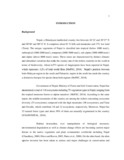Please use this identifier to cite or link to this item:
http://archive.nnl.gov.np:8080/handle/123456789/366| Title: | Impacts of Invasive Alien Species on Native Vegetation in Central Nepal Lal Bahadur Thapa A Thesis Submitted in Partial Fulfillment of the Requirements for the Degree of Doctor of Philosophy in Biology Prince of Songkla University 2016 Copyright of |
| Authors: | Thapa, Lal Bahadur |
| Keywords: | The vegetation surveys had been conducted in a tropical “Sal” forest (Chitwan district) and a lower montane Champadevi hill forest (Kathmandu district) of the Central Nepal in order to study the impacts of invasive alien species on native vegetation in central Nepal. Due to the present aspect, the alien species to Nepal i.e. Ageratina adenophora (Spreng.) R.M. King & H. Rob and Chromolaena odorata (L.) King & Robinson were selected as they grow invasively in the natural forest of the central Nepal. Five types of plant communities identified in the Champadevi hill forest were characteristic in terms of the species composition, structures, habitats as well as locations. The Schima-Alnus plant communities were highly invaded by A. adenophora. Native species richness and density were significantly low in A. adenophora invaded sites. |
| Issue Date: | 25-Mar-2019 |
| Abstract: | The vegetation surveys had been conducted in a tropical “Sal” forest (Chitwan district) and a lower montane Champadevi hill forest (Kathmandu district) of the Central Nepal in order to study the impacts of invasive alien species on native vegetation in central Nepal. Due to the present aspect, the alien species to Nepal i.e. Ageratina adenophora (Spreng.) R.M. King & H. Rob and Chromolaena odorata (L.) King & Robinson were selected as they grow invasively in the natural forest of the central Nepal. Five types of plant communities identified in the Champadevi hill forest were characteristic in terms of the species composition, structures, habitats as well as locations. The Schima-Alnus plant communities were highly invaded by A. adenophora. Native species richness and density were significantly low in A. adenophora invaded sites. Likewise, the species composition; native species richness as well as the Shorea robusta C.F. Gaertn. (“Sal” tree) seedlings were severely impacted by C. odorata in the tropical “Sal” forest. The experiments had shown that A. adenophora invaded soil, its litter and the air born effect of litter had inhibited seedling growth and development of Schima wallichii (DC.) Korth. Fresh leaves and leaf extract of A. adenophora had inhibited the growth of seedlings of S. wallichii and Alnus nepalensis D. Don. Moreover, A. adenohora litter had reduced the root growth of S. wallichii at the lower seedling densities. A. adenophora invasion was lowered at higher altitude and under higher tree canopy. Both the invasive species have threatened natural vegetation by suppressing native species through different mechanisms of inhibition. Soil-based phytotoxins has contributed to the A. adenophora invasion. Adjustments of native seedling density and maintenance of tree canopy could be possible management strategy for A. adenophora invasion. |
| URI: | http://103.69.125.248:8080/xmlui/handle/123456789/366 |
| Appears in Collections: | 500 Natural sciences and mathematics |
Files in This Item:
| File | Description | Size | Format | |
|---|---|---|---|---|
| 1. Cover page, Inner cover page, Certifications.pdf | 166.87 kB | Adobe PDF |  View/Open | |
| 2. Abstract, Acknowledgement, Contents, List of figures, Abbreviations, List of papers and Journal permissions.pdf | 1.17 MB | Adobe PDF |  View/Open | |
| 3. Body Thesis.pdf | 21.79 MB | Adobe PDF |  View/Open |
Items in DSpace are protected by copyright, with all rights reserved, unless otherwise indicated.